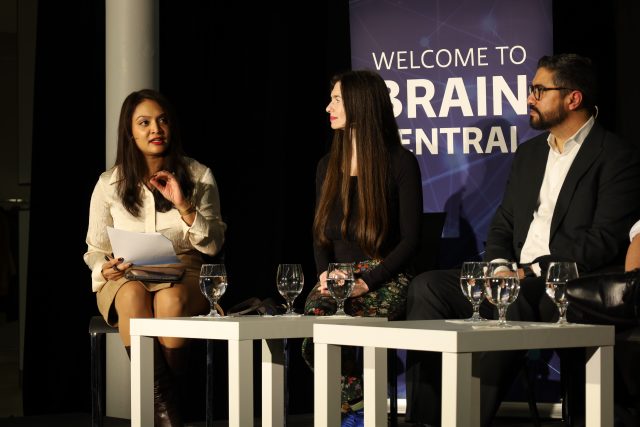
OBI is working towards creating an inclusive society for neurodiverse people that accommodates a vast range of needs. In the last decade alone, we have seen plenty of promising tech coming out of Ontario’s neurotech cluster. Entrepreneurs and researchers are coming up with creative solutions to directly address barriers that exist for people with brain disorders in becoming active members of society.
Put simply, these advancements in neurotechnology are the result of us getting better at taking a great idea developed in the lab and translating it into a tangible tool that can help people lead fuller lives.
Earlier this year, OBI hosted a Public Talk, “The Transformative Power of Neurotechnology”, with a group of incredible panelists who all have significant expertise in the area of neurotechnology. Hosted by Rackeb Tesfaye, the panelists shared their direct experience and stories of the evolution of neurotechnology, and how Ontario’s neurotech community can continue to build on the significant momentum.
What are the key ingredients needed in moving neurotech from lab to life?
1.Engaging people with lived experience – Diane Dewing, a mother of four including Jessica – a non-verbal 35-year-old woman living with anxiety used the example of Anxiety Meter, a wearable technology developed to help children on the Autism Spectrum and intellectual disabilities. By engaging people with lived experience and families we can ensure these products are tested for user experience, designed for ones who are going to use them at the end of the day and are reliable pieces of technology.
2. Research and industry partnerships – Sharon Wong, Director of Commercialization at Holland Bloorview Kids Rehabilitation Centre spoke of the need for researchers and industry to collaborate and partner. “OBI was instrumental in this. They were the ones who introduced us to Andrea and Awake Labs; they started that conversation,” said Sharon Wong, with Holland Bloorview. “With the help of connectors like OBI, we are able to secure these types of partnerships.”3
3. Programs and funding to support entrepreneurs – Andrea Palmer, Founder and CEO of Awake Labs – the organization behind Anxiety Meter, and an alumni of OBI’s ONtrepreneurs program, spoke of the benefits of programs and funding in the province that support and promote early-stage entrepreneurs to commercialize neurotech. The Anxiety Meter has now moved into the commercialization phase through support from OBI and researchers from Holland Bloorview Kids Rehabilitation Hospital – making the anxiety wearable available to children and families.
4.Engage care workers – Angel Vibert, Director of Community Residential Services and Community Living North Bay spoke about the importance of engaging care workers in the process of introducing neurotechnology supports to day-to-day care. This included creating an environment that welcomed feedback and taking time for thorough training to use the technology. “The primary staff was positioned as the lead; the lead with the individual, the lead with communication with the families, clinicians and Awake Labs.”
5.Collaborative research – “I can think of no better place for collaborative research to thrive than right here in Ontario. Our province continues to be a global leader in science productivity and is home to over 800 neuroscientists, one of the highest concentrations of professionals in the world,” said the Hon. Ross Romano, Minister of Colleges and Universities in his opening remarks to kick-off the discussion. “The transparent, inclusive and collaborative approach being done at OBI allows us to establish sustainable partnerships across sectors and supports Ontario-made research to reach commercial markets – both domestic and international.”
The full OBI Public Talk can be found on OBI’s YouTube channel.
